Tanenbaum A. Computer Networks
Подождите немного. Документ загружается.

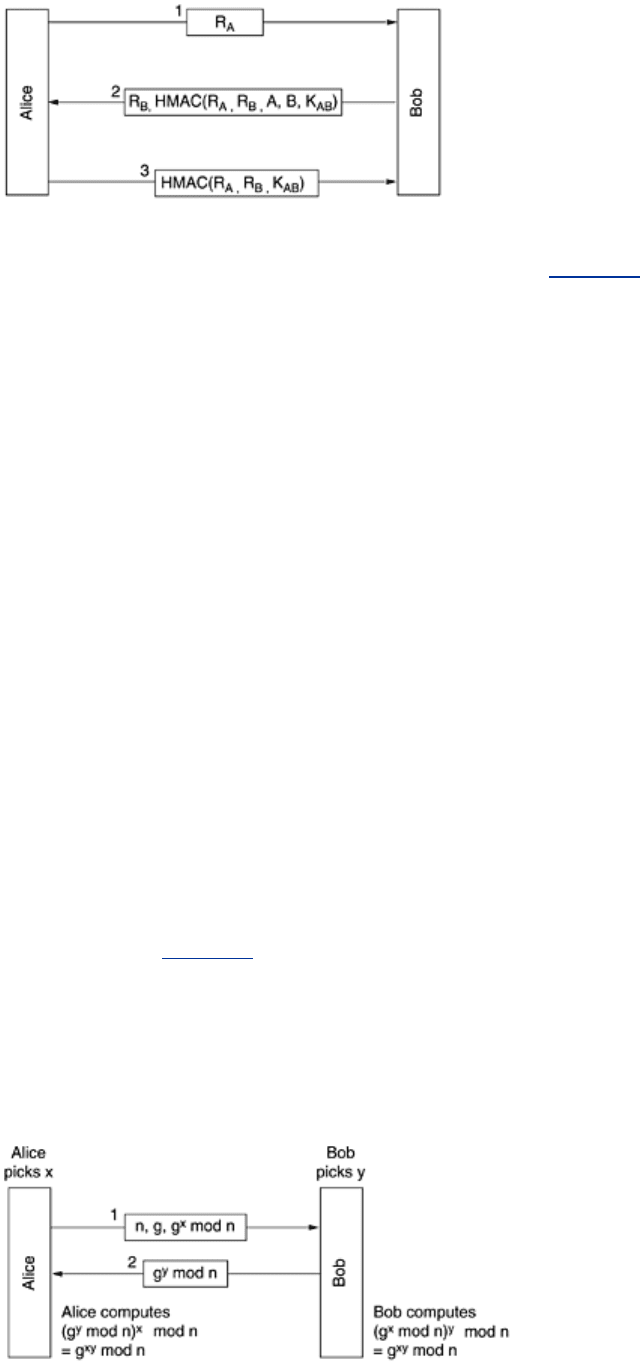
Can Trudy somehow subvert this protocol? No, because she cannot force either party to
encrypt or hash a value of her choice, as happened in
Fig. 8-34 and Fig. 8-(Fo. Both HMACs
include values chosen by the sending party, something which Trudy cannot control.
Using HMACs is not the only way to use this idea. An alternative scheme that is often used
instead of computing the HMAC over a series of items is to encrypt the items sequentially
using cipher block chaining.
8.7.2 Establishing a Shared Key: The Diffie-Hellman Key Exchange
So far we have assumed that Alice and Bob share a secret key. Suppose that they do not
(because so far there is no universally accepted PKI for signing and distributing certificates).
How can they establish one? One way would be for Alice to call Bob and give him her key on
the phone, but he would probably start out by saying: How do I know you are Alice and not
Trudy? They could try to arrange a meeting, with each one bringing a passport, a drivers'
license, and three major credit cards, but being busy people, they might not be able to find a
mutually acceptable date for months. Fortunately, incredible as it may sound, there is a way
for total strangers to establish a shared secret key in broad daylight, even with Trudy carefully
recording every message.
The protocol that allows strangers to establish a shared secret key is called the
Diffie-
Hellman key exchange
(Diffie and Hellman, 1976) and works as follows. Alice and Bob have
to agree on two large numbers,
n and g, where n is a prime, (n - 1)/2 is also a prime and
certain conditions apply to
g. These numbers may be public, so either one of them can just
pick
n and g and tell the other openly. Now Alice picks a large (say, 512-bit) number, x, and
keeps it secret. Similarly, Bob picks a large secret number,
y.
Alice initiates the key exchange protocol by sending Bob a message containing (
n, g, g
x
mod
n), as shown in Fig. 8-37. Bob responds by sending Alice a message containing g
y
mod n. Now
Alice raises the number Bob sent her to the
xth power modulo n to get (g
y
mod n)
x
mod n. Bob
performs a similar operation to get (
g
x
mod n)
y
mod n. By the laws of modular arithmetic, both
calculations yield
g
xy
mod n. Lo and behold, Alice and Bob suddenly share a secret key, g
xy
mod
n.
Figure 8-37. The Diffie-Hellman key exchange.
611
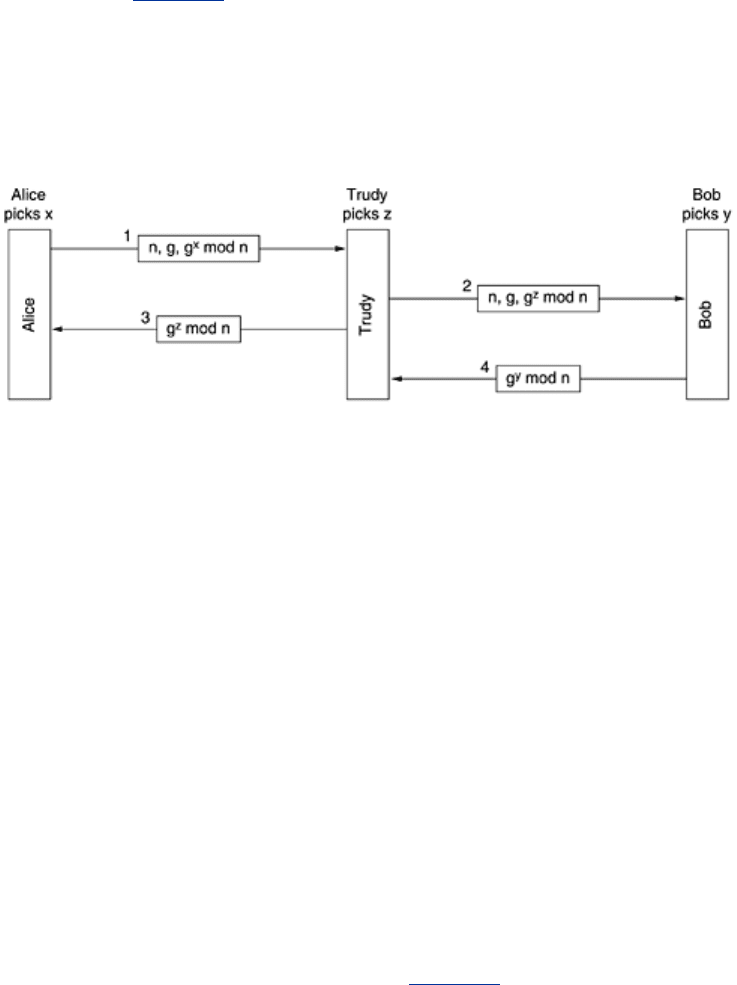
Trudy, of course, has seen both messages. She knows g and n from message 1. If she could
compute
x and y, she could figure out the secret key. The trouble is, given only g
x
mod n, she
cannot find
x. No practical algorithm for computing discrete logarithms modulo a very large
prime number is known.
To make the above example more concrete, we will use the (completely unrealistic) values of
n
= 47 and
g = 3. Alice picks x = 8 and Bob picks y = 10. Both of these are kept secret. Alice's
message to Bob is (47, 3, 28) because 3
8
mod 47 is 28. Bob's message to Alice is (17). Alice
computes 17
8
mod 47, which is 4. Bob computes 28
10
mod 47, which is 4. Alice and Bob have
independently determined that the secret key is now 4. Trudy has to solve the equation 3
x
mod 47 = 28, which can be done by exhaustive search for small numbers like this, but not
when all the numbers are hundreds of bits long. All currently-known algorithms simply take
too long, even on massively parallel supercomputers.
Despite the elegance of the Diffie-Hellman algorithm, there is a problem: when Bob gets the
triple (47, 3, 28), how does he know it is from Alice and not from Trudy? There is no way he
can know. Unfortunately, Trudy can exploit this fact to deceive both Alice and Bob, as
illustrated in
Fig. 8-38. Here, while Alice and Bob are choosing x and y, respectively, Trudy
picks her own random number,
z. Alice sends message 1 intended for Bob. Trudy intercepts it
and sends message 2 to Bob, using the correct
g and n (which are public anyway) but with her
own
z instead of x. She also sends message 3 back to Alice. Later Bob sends message 4 to
Alice, which Trudy again intercepts and keeps.
Figure 8-38. The bucket brigade or man-in-the-middle attack.
Now everybody does the modular arithmetic. Alice computes the secret key as
g
xz
mod n, and
so does Trudy (for messages to Alice). Bob computes
g
yz
mod n and so does Trudy (for
messages to Bob). Alice thinks she is talking to Bob so she establishes a session key (with
Trudy). So does Bob. Every message that Alice sends on the encrypted session is captured by
Trudy, stored, modified if desired, and then (optionally) passed on to Bob. Similarly, in the
other direction. Trudy sees everything and can modify all messages at will, while both Alice
and Bob are under the illusion that they have a secure channel to one another. This attack is
known as the
bucket brigade attack, because it vaguely resembles an old-time volunteer fire
department passing buckets along the line from the fire truck to the fire. It is also called the
man-in-the-middle attack.
8.7.3 Authentication Using a Key Distribution Center
Setting up a shared secret with a stranger almost worked, but not quite. On the other hand, it
probably was not worth doing in the first place (sour grapes attack). To talk to
n people this
way, you would need
n keys. For popular people, key management would become a real
burden, especially if each key had to be stored on a separate plastic chip card.
A different approach is to introduce a trusted key distribution center (KDC). In this model,
each user has a single key shared with the KDC. Authentication and session key management
now goes through the KDC. The simplest known KDC authentication protocol involving two
parties and a trusted KDC is depicted in
Fig. 8-39.
612

Figure 8-39. A first attempt at an authentication protocol using a KDC.
The idea behind this protocol is simple: Alice picks a session key,
K
S
, and tells the KDC that
she wants to talk to Bob using
K
S
. This message is encrypted with the secret key Alice shares
(only) with the KDC,
K
A
. The KDC decrypts this message, extracting Bob's identity and the
session key. It then constructs a new message containing Alice's identity and the session key
and sends this message to Bob. This encryption is done with
K
B
, the secret key Bob shares
with the KDC. When Bob decrypts the message, he learns that Alice wants to talk to him and
which key she wants to use.
The authentication here happens for free. The KDC knows that message 1 must have come
from Alice, since no one else would have been able to encrypt it with Alice's secret key.
Similarly, Bob knows that message 2 must have come from the KDC, whom he trusts, since no
one else knows his secret key.
Unfortunately, this protocol has a serious flaw. Trudy needs some money, so she figures out
some legitimate service she can perform for Alice, makes an attractive offer, and gets the job.
After doing the work, Trudy then politely requests Alice to pay by bank transfer. Alice then
establishes a session key with her banker, Bob. Then she sends Bob a message requesting
money to be transferred to Trudy's account.
Meanwhile, Trudy is back to her old ways, snooping on the network. She copies both message
2 in
Fig. 8-39 and the money-transfer request that follows it. Later, she replays both of them
to Bob. Bob gets them and thinks: Alice must have hired Trudy again. She clearly does good
work. Bob then transfers an equal amount of money from Alice's account to Trudy's. Some
time after the 50th message pair, Bob runs out of the office to find Trudy to offer her a big
loan so she can expand her obviously successful business. This problem is called the
replay
attack
.
Several solutions to the replay attack are possible. The first one is to include a timestamp in
each message. Then if anyone receives an obsolete message, it can be discarded. The trouble
with this approach is that clocks are never exactly synchronized over a network, so there has
to be some interval during which a timestamp is valid. Trudy can replay the message during
this interval and get away with it.
The second solution is to put a nonce in each message. Each party then has to remember all
previous nonces and reject any message containing a previously-used nonce. But nonces have
to be remembered forever, lest Trudy try replaying a 5-year-old message. Also, if some
machine crashes and it loses its nonce list, it is again vulnerable to a replay attack.
Timestamps and nonces can be combined to limit how long nonces have to be remembered,
but clearly the protocol is going to get a lot more complicated.
A more sophisticated approach to mutual authentication is to use a multiway challenge-
response protocol. A well-known example of such a protocol is the
Needham-Schroeder
authentication
protocol (Needham and Schroeder, 1978), one variant of which is shown in
Fig. 8-40.
Figure 8-40. The Needham-Schroeder authentication protocol.
613

The protocol begins with Alice telling the KDC that she wants to talk to Bob. This message
contains a large random number,
R
A
, as a nonce. The KDC sends back message 2 containing
Alice's random number, a session key, and a ticket that she can send to Bob. The point of the
random number,
R
A
, is to assure Alice that message 2 is fresh, and not a replay. Bob's identity
is also enclosed in case Trudy gets any funny ideas about replacing
B in message 1 with her
own identity so the KDC will encrypt the ticket at the end of message 2 with
K
T
instead of K
B
.
The ticket encrypted with
K
B
is included inside the encrypted message to prevent Trudy from
replacing it with something else on the way back to Alice.
Alice now sends the ticket to Bob, along with a new random number,
R
A2
, encrypted with the
session key,
K
S
. In message 4, Bob sends back K
S
(R
A2
- 1) to prove to Alice that she is talking
to the real Bob. Sending back
K
S
(R
A2
) would not have worked, since Trudy could just have
stolen it from message 3.
After receiving message 4, Alice is now convinced that she is talking to Bob and that no
replays could have been used so far. After all, she just generated
R
A2
a few milliseconds ago.
The purpose of message 5 is to convince Bob that it is indeed Alice he is talking to, and no
replays are being used here either. By having each party both generate a challenge and
respond to one, the possibility of any kind of replay attack is eliminated.
Although this protocol seems pretty solid, it does have a slight weakness. If Trudy ever
manages to obtain an old session key in plaintext, she can initiate a new session with Bob by
replaying the message 3 corresponding to the compromised key and convince him that she is
Alice (Denning and Sacco, 1981). This time she can plunder Alice's bank account without
having to perform the legitimate service even once.
Needham and Schroeder later published a protocol that corrects this problem (Needham and
Schroeder, 1987). In the same issue of the same journal, Otway and Rees (1987) also
published a protocol that solves the problem in a shorter way.
Figure 8-41 shows a slightly
modified Otway-Rees protocol.
Figure 8-41. The Otway-Rees authentication protocol (slightly
simplified).
In the Otway-Rees protocol, Alice starts out by generating a pair of random numbers,
R, which
will be used as a common identifier, and
R
A
, which Alice will use to challenge Bob. When Bob
614

gets this message, he constructs a new message from the encrypted part of Alice's message
and an analogous one of his own. Both the parts encrypted with
K
A
and K
B
identify Alice and
Bob, contain the common identifier, and contain a challenge.
The KDC checks to see if the
R in both parts is the same. It might not be because Trudy
tampered with
R in message 1 or replaced part of message 2. If the two Rs match, the KDC
believes that the request message from Bob is valid. It then generates a session key and
encrypts it twice, once for Alice and once for Bob. Each message contains the receiver's
random number, as proof that the KDC, and not Trudy, generated the message. At this point
both Alice and Bob are in possession of the same session key and can start communicating.
The first time they exchange data messages, each one can see that the other one has an
identical copy of
K
S
, so the authentication is then complete.
8.7.4 Authentication Using Kerberos
An authentication protocol used in many real systems (including Windows 2000) is Kerberos,
which is based on a variant of Needham-Schroeder. It is named for a multiheaded dog in
Greek mythology that used to guard the entrance to Hades (presumably to keep undesirables
out). Kerberos was designed at M.I.T. to allow workstation users to access network resources
in a secure way. Its biggest difference from Needham-Schroeder is its assumption that all
clocks are fairly well synchronized. The protocol has gone through several iterations. V4 is the
version most widely used in industry, so we will describe it. Afterward, we will say a few words
about its successor, V5. For more information, see (Steiner et al., 1988).
Kerberos involves three servers in addition to Alice (a client workstation):
Authentication Server (AS): verifies users during login
Ticket-Granting Server (TGS): issues ''proof of identity tickets''
Bob the server: actually does the work Alice wants performed
AS is similar to a KDC in that it shares a secret password with every user. The TGS's job is to
issue tickets that can convince the real servers that the bearer of a TGS ticket really is who he
or she claims to be.
To start a session, Alice sits down at an arbitrary public workstation and types her name. The
workstation sends her name to the AS in plaintext, as shown in
Fig. 8-42. What comes back is
a session key and a ticket,
K
TGS
(A, K
S
), intended for the TGS. These items are packaged
together and encrypted using Alice's secret key, so that only Alice can decrypt them. Only
when message 2 arrives does the workstation ask for Alice's password. The password is then
used to generate
K
A
in order to decrypt message 2 and obtain the session key and TGS ticket
inside it. At this point, the workstation overwrites Alice's password to make sure that it is only
inside the workstation for a few milliseconds at most. If Trudy tries logging in as Alice, the
password she types will be wrong and the workstation will detect this because the standard
part of message 2 will be incorrect.
Figure 8-42. The operation of Kerberos V4.
615
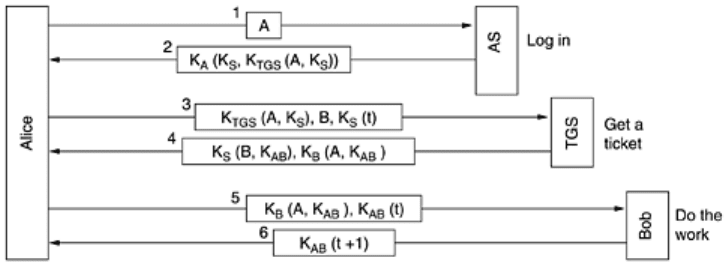
After she logs in, Alice may tell the workstation that she wants to contact Bob the file server.
The workstation then sends message 3 to the TGS asking for a ticket to use with Bob. The key
element in this request is
K
TGS
(A, K
S
), which is encrypted with the TGS's secret key and used
as proof that the sender really is Alice. The TGS responds by creating a session key,
K
AB
, for
Alice to use with Bob. Two versions of it are sent back. The first is encrypted with only
K
S
, so
Alice can read it. The second is encrypted with Bob's key,
K
B
, so Bob can read it.
Trudy can copy message 3 and try to use it again, but she will be foiled by the encrypted
timestamp,
t, sent along with it. Trudy cannot replace the timestamp with a more recent one,
because she does not know
K
S
, the session key Alice uses to talk to the TGS. Even if Trudy
replays message 3 quickly, all she will get is another copy of message 4, which she could not
decrypt the first time and will not be able to decrypt the second time either.
Now Alice can send
K
AB
to Bob to establish a session with him. This exchange is also
timestamped. The response is proof to Alice that she is actually talking to Bob, not to Trudy.
After this series of exchanges, Alice can communicate with Bob under cover of
K
AB
. If she later
decides she needs to talk to another server, Carol, she just repeats message 3 to the TGS,
only now specifying
C instead of B. The TGS will promptly respond with a ticket encrypted with
K
C
that Alice can send to Carol and that Carol will accept as proof that it came from Alice.
The point of all this work is that now Alice can access servers all over the network in a secure
way and her password never has to go over the network. In fact, it only had to be in her own
workstation for a few milliseconds. However, note that each server does its own authorization.
When Alice presents her ticket to Bob, this merely proves to Bob who sent it. Precisely what
Alice is allowed to do is up to Bob.
Since the Kerberos designers did not expect the entire world to trust a single authentication
server, they made provision for having multiple
realms, each with its own AS and TGS. To get
a ticket for a server in a distant realm, Alice would ask her own TGS for a ticket accepted by
the TGS in the distant realm. If the distant TGS has registered with the local TGS (the same
way local servers do), the local TGS will give Alice a ticket valid at the distant TGS. She can
then do business over there, such as getting tickets for servers in that realm. Note, however,
that for parties in two realms to do business, each one must trust the other's TGS.
Kerberos V5 is fancier than V4 and has more overhead. It also uses OSI ASN.1 (Abstract
Syntax Notation 1) for describing data types and has small changes in the protocols.
Furthermore, it has longer ticket lifetimes, allows tickets to be renewed, and will issue
postdated tickets. In addition, at least in theory, it is not DES dependent, as V4 is, and
supports multiple realms by delegating ticket generation to multiple ticket servers.
8.7.5 Authentication Using Public-Key Cryptography
Mutual authentication can also be done using public-key cryptography. To start with, Alice
needs to get Bob's public key. If a PKI exists with a directory server that hands out certificates
616
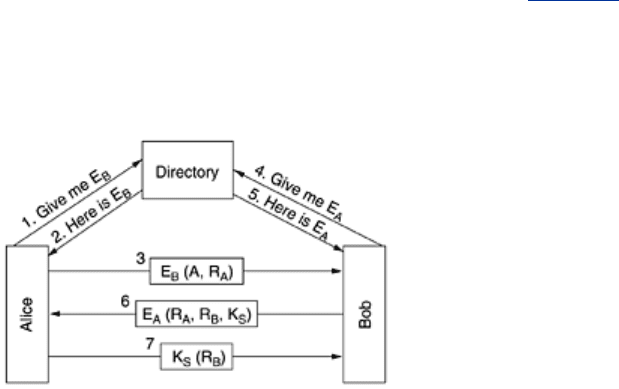
for public keys, Alice can ask for Bob's, as shown in Fig. 8-43 as message 1. The reply, in
message 2, is an X.509 certificate containing Bob's public key. When Alice verifies that the
signature is correct, she sends Bob a message containing her identity and a nonce.
Figure 8-43. Mutual authentication using public-key cryptography.
When Bob receives this message, he has no idea whether it came from Alice or from Trudy,
but he plays along and asks the directory server for Alice's public key (message 4) which he
soon gets (message 5). He then sends Alice a message containing Alice's
R
A
, his own nonce,
R
B
, and a proposed session key, K
S
, as message 6.
When Alice gets message 6, she decrypts it using her private key. She sees
R
A
in it, which
gives her a warm feeling inside. The message must have come from Bob, since Trudy has no
way of determining
R
A
. Furthermore, it must be fresh and not a replay, since she just sent Bob
R
A
. Alice agrees to the session by sending back message 7. When Bob sees R
B
encrypted with
the session key he just generated, he knows Alice got message 6 and verified
R
A
.
What can Trudy do to try to subvert this protocol? She can fabricate message 3 and trick Bob into
probing Alice, but Alice will see an
R
A
that she did not send and will not proceed further. Trudy
cannot forge message 7 back to Bob because she does not know
R
B
or K
S
and cannot determine
them without Alice's private key. She is out of luck.
8.8 E-Mail Security
When an e-mail message is sent between two distant sites, it will generally transit dozens of
machines on the way. Any of these can read and record the message for future use. In
practice, privacy is nonexistent, despite what many people think. Nevertheless, many people
would like to be able to send e-mail that can be read by the intended recipient and no one
else: not their boss and not even their government. This desire has stimulated several people
and groups to apply the cryptographic principles we studied earlier to e-mail to produce secure
e-mail. In the following sections we will study a widely-used secure e-mail system, PGP, and
then briefly mention two others, PEM and S/MIME. For additional information about secure e-
mail, see (Kaufman et al., 2002; and Schneier, 1995).
8.8.1 PGP—Pretty Good Privacy
Our first example, PGP (Pretty Good Privacy) is essentially the brainchild of one person, Phil
Zimmermann (Zimmermann, 1995a, 1995b). Zimmermann is a privacy advocate whose motto
is: If privacy is outlawed, only outlaws will have privacy. Released in 1991, PGP is a complete
e-mail security package that provides privacy, authentication, digital signatures, and
compression, all in an easy-to-use form. Furthermore, the complete package, including all the
source code, is distributed free of charge via the Internet. Due to its quality, price (zero), and
easy availability on UNIX, Linux, Windows, and Mac OS platforms, it is widely used today.
617

PGP encrypts data by using a block cipher called IDEA (International Data Encryption
Algorithm
), which uses 128-bit keys. It was devised in Switzerland at a time when DES was
seen as tainted and AES had not yet been invented. Conceptually, IDEA is similar to DES and
AES: it mixes up the bits in a series of rounds, but the details of the mixing functions are
different from DES and AES. Key management uses RSA and data integrity uses MD5, topics
that we have already discussed.
PGP has also been embroiled in controversy since day 1 (Levy, 1993). Because Zimmermann
did nothing to stop other people from placing PGP on the Internet, where people all over the
world could get it, the U.S. Government claimed that Zimmermann had violated U.S. laws
prohibiting the export of munitions. The U.S. Government's investigation of Zimmermann went
on for 5 years, but was eventually dropped, probably for two reasons. First, Zimmermann did
not place PGP on the Internet himself, so his lawyer claimed that
he never exported anything
(and then there is the little matter of whether creating a Web site constitutes export at all).
Second, the government eventually came to realize that winning a trial meant convincing a
jury that a Web site containing a downloadable privacy program was covered by the arms-
trafficking law prohibiting the export of war materiel such as tanks, submarines, military
aircraft, and nuclear weapons. Years of negative publicity probably did not help much, either.
As an aside, the export rules are bizarre, to put it mildly. The government considered putting
code on a Web site to be an illegal export and harassed Zimmermann for 5 years about it. On
the other hand, when someone published the complete PGP source code, in C, as a book (in a
large font with a checksum on each page to make scanning it in easy) and then exported the
book, that was fine with the government because books are not classified as munitions. The
sword is mightier than the pen, at least for Uncle Sam.
Another problem PGP ran into involved patent infringement. The company holding the RSA
patent, RSA Security, Inc., alleged that PGP's use of the RSA algorithm infringed on its patent,
but that problem was settled with releases starting at 2.6. Furthermore, PGP uses another
patented encryption algorithm, IDEA, whose use caused some problems at first.
Since PGP is open source, various people and groups have modified it and produced a number
of versions. Some of these were designed to get around the munitions laws, others were
focused on avoiding the use of patented algorithms, and still others wanted to turn it into a
closed-source commercial product. Although the munitions laws have now been slightly
liberalized (otherwise products using AES would not have been exportable from the U.S.), and
the RSA patent expired in September 2000, the legacy of all these problems is that several
incompatible versions of PGP are in circulation, under various names. The discussion below
focuses on classic PGP, which is the oldest and simplest version. Another popular version,
Open PGP, is described in RFC 2440. Yet another is the GNU Privacy Guard.
PGP intentionally uses existing cryptographic algorithms rather than inventing new ones. It is
largely based on algorithms that have withstood extensive peer review and were not designed
or influenced by any government agency trying to weaken them. For people who tend to
distrust government, this property is a big plus.
PGP supports text compression, secrecy, and digital signatures and also provides extensive key
management facilities, but oddly enough, not e-mail facilities. It is more of a preprocessor that
takes plaintext as input and produces signed ciphertext in base64 as output. This output can
then be e-mailed, of course. Some PGP implementations call a user agent as the final step to
actually send the message.
To see how PGP works, let us consider the example of
Fig. 8-44. Here, Alice wants to send a
signed plaintext message,
P, to Bob in a secure way. Both Alice and Bob have private (D
X
) and
public (
E
X
) RSA keys. Let us assume that each one knows the other's public key; we will cover
PGP key management shortly.
618
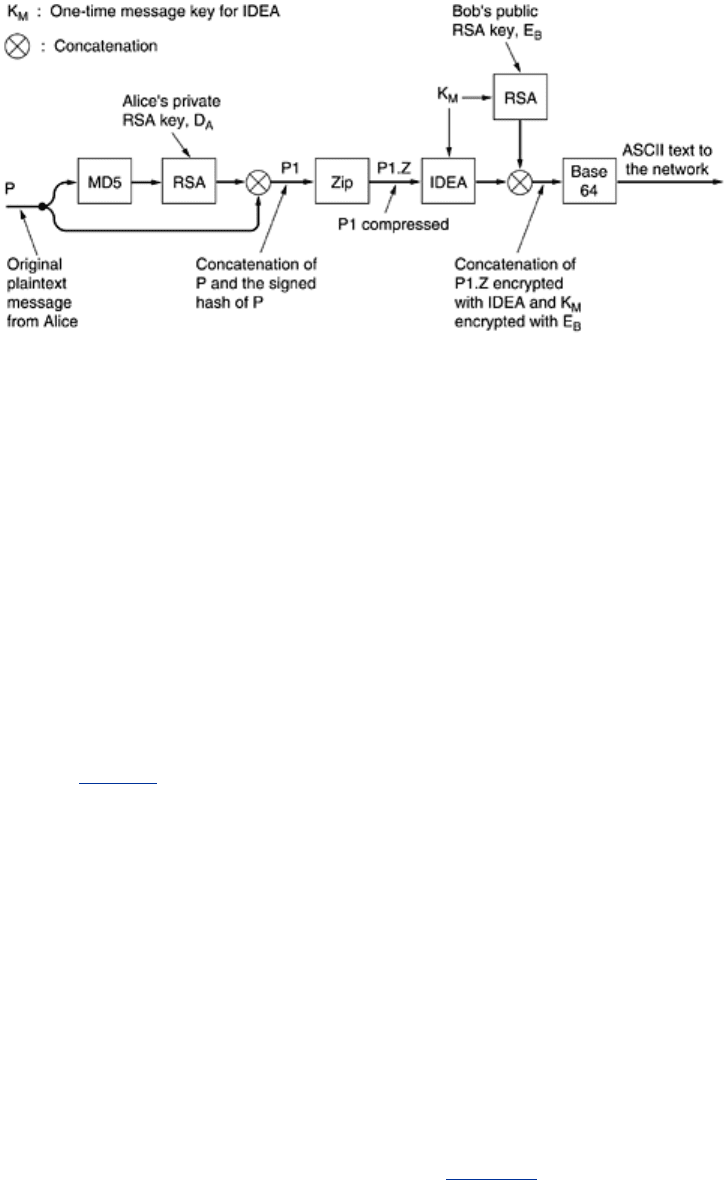
Figure 8-44. PGP in operation for sending a message.
Alice starts out by invoking the PGP program on her computer. PGP first hashes her message,
P, using MD5, and then encrypts the resulting hash using her private RSA key, D
A
. When Bob
eventually gets the message, he can decrypt the hash with Alice's public key and verify that
the hash is correct. Even if someone else (e.g., Trudy) could acquire the hash at this stage and
decrypt it with Alice's known public key, the strength of MD5 guarantees that it would be
computationally infeasible to produce another message with the same MD5 hash.
The encrypted hash and the original message are now concatenated into a single message,
P1,
and compressed using the ZIP program, which uses the Ziv-Lempel algorithm (Ziv and Lempel,
1977). Call the output of this step
P1.Z.
Next, PGP prompts Alice for some random input. Both the content and the typing speed are
used to generate a 128-bit IDEA message key,
K
M
(called a session key in the PGP literature,
but this is really a misnomer since there is no session).
K
M
is now used to encrypt P1.Z with
IDEA in cipher feedback mode. In addition,
K
M
is encrypted with Bob's public key, E
B
. These
two components are then concatenated and converted to base64, as we discussed in the
section on MIME in
Chap. 7. The resulting message then contains only letters, digits, and the
symbols +, /, and =, which means it can be put into an RFC 822 body and be expected to
arrive unmodified.
When Bob gets the message, he reverses the base64 encoding and decrypts the IDEA key
using his private RSA key. Using this key, he decrypts the message to get
P1.Z. After
decompressing it, Bob separates the plaintext from the encrypted hash and decrypts the hash
using Alice's public key. If the plaintext hash agrees with his own MD5 computation, he knows
that
P is the correct message and that it came from Alice.
It is worth noting that RSA is only used in two places here: to encrypt the 128-bit MD5 hash
and to encrypt the 128-bit IDEA key. Although RSA is slow, it has to encrypt only 256 bits, not
a large volume of data. Furthermore, all 256 plaintext bits are exceedingly random, so a
considerable amount of work will be required on Trudy's part just to determine if a guessed
key is correct. The heavyduty encryption is done by IDEA, which is orders of magnitude faster
than RSA. Thus, PGP provides security, compression, and a digital signature and does so in a
much more efficient way than the scheme illustrated in
Fig. 8-19.
PGP supports four RSA key lengths. It is up to the user to select the one that is most
appropriate. The lengths are
1. Casual (384 bits): can be broken easily today.
2. Commercial (512 bits): breakable by three-letter organizations.
3. Military (1024 bits): Not breakable by anyone on earth.
619
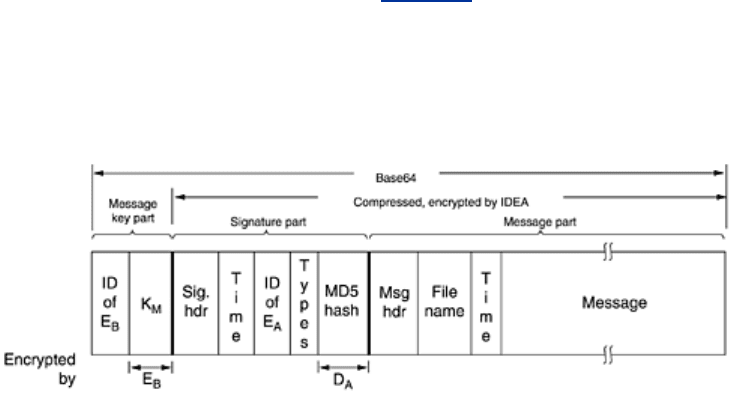
4. Alien (2048 bits): Not breakable by anyone on other planets, either.
Since RSA is only used for two small computations, everyone should use alien strength keys all
the time.
The format of a classic PGP message is shown in
Fig. 8-45. Numerous other formats are also in
use. The message has three parts, containing the IDEA key, the signature, and the message,
respectively. The key part contains not only the key, but also a key identifier, since users are
permitted to have multiple public keys.
Figure 8-45. A PGP message.
The signature part contains a header, which will not concern us here. The header is followed by
a timestamp, the identifier for the sender's public key that can be used to decrypt the
signature hash, some type information that identifies the algorithms used (to allow MD6 and
RSA2 to be used when they are invented), and the encrypted hash itself.
The message part also contains a header, the default name of the file to be used if the receiver
writes the file to the disk, a message creation timestamp, and, finally, the message itself.
Key management has received a large amount of attention in PGP as it is the Achilles heel of
all security systems. Key management works as follows. Each user maintains two data
structures locally: a private key ring and a public key ring. The
private key ring contains one
or more personal private-public key pairs. The reason for supporting multiple pairs per user is
to permit users to change their public keys periodically or when one is thought to have been
compromised, without invalidating messages currently in preparation or in transit. Each pair
has an identifier associated with it so that a message sender can tell the recipient which public
key was used to encrypt it. Message identifiers consist of the low-order 64 bits of the public
key. Users are responsible for avoiding conflicts in their public key identifiers. The private keys
on disk are encrypted using a special (arbitrarily long) password to protect them against sneak
attacks.
The
public key ring contains public keys of the user's correspondents. These are needed to
encrypt the message keys associated with each message. Each entry on the public key ring
contains not only the public key, but also its 64-bit identifier and an indication of how strongly
the user trusts the key.
The problem being tackled here is the following. Suppose that public keys are maintained on
bulletin boards. One way for Trudy to read Bob's secret e-mail is to attack the bulletin board
and replace Bob's public key with one of her choice. When Alice later fetches the key allegedly
belonging to Bob, Trudy can mount a bucket brigade attack on Bob.
To prevent such attacks, or at least minimize the consequences of them, Alice needs to know
how much to trust the item called ''Bob's key'' on her public key ring. If she knows that Bob
personally handed her a floppy disk containing the key, she can set the trust value to the
620
